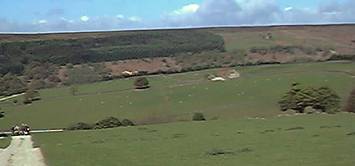
Back to the Index page
[Species lists below]
13 members met on the moor above Moor House at 9:00am on a slightly misty morning. However the mist soon lifted to leave bright clear sun and patchy cumulus cloud blown along by a cool westerly breeze. Tom Denney led us down past a couple of farms, through fields with very inquisitive sheep in them, to the Hodge Beck, then looped around Stork House, down the far side of the valley before crossing back and heading across to the road bridge at Ouse Gill and finally back across the moor to the cars. We were on moorland and moor-foot land with pasture intakes plus wooded streamsides, with bankside oak woodland on acid soils on the west bank of the Hodge Beck and some limited wetter areas. The whole area lies on the Lias shales and overlying sandstones (the picture below shows a small exposure of typical very friable “paper shales” with a pencil for scale).

We saw or heard 35 bird species, and recorded more than 70 plants, including a wonderful display of crab apple blossom. There were also at least two sedges and several mosses which I could not identify, an interesting beetle on a rabbit carcase, one white butterfly and a small whitish moth. The highlights for me were the redstart, pied flycatcher, ring ouzel, whinchat and wheatear, all of which we saw clearly if only briefly. Tom had his telescope, which gave us wonderful views of many of the birds: one of the redstarts which was singing at the top of a small tree, and the whinchats posed particularly nicely for us.
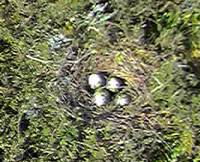
The very first thing Tom showed us was a peewit’s nest down in the heather. It was very well camouflaged,
and it would have been easy to tread on the eggs without paying close attention to where we were walking.
There were several pairs of peewits on the moorland and some of the pasture fields but this was the
only nest we saw. We did see some very young grouse chicks a little later.

The area down by the beck (left) was classic pied flycatcher country, with oak trees down by the water
and running up the banks in fairly open woodland. We could hear a bird singing as we approached the
valley bottom, but it was not until we were above the trees on the other side looking down that we managed
to spot him.
As we walked along the valley side the views were superb, with a lovely clear light across the upper dale:
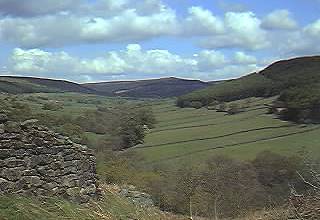
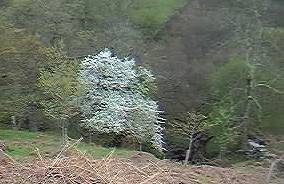
There were some crab apple trees covered in blossom, as seen here (right). 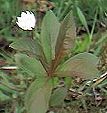 A little further along the bank we walked through an area of oak woodland with interesting ground flora,
including wood sorrel (some of it the pink variety), and a couple of relatively uncommon plants: climbing
corydalis Ceratocapnos claviculata and chickweed wintergreen Trientalis europaea, both
of which were only just coming into flower. I managed to get a photo of the latter (left).
A little further along the bank we walked through an area of oak woodland with interesting ground flora,
including wood sorrel (some of it the pink variety), and a couple of relatively uncommon plants: climbing
corydalis Ceratocapnos claviculata and chickweed wintergreen Trientalis europaea, both
of which were only just coming into flower. I managed to get a photo of the latter (left).
When we crossed back over the beck a little to the south of Stork House we noticed a concrete dam or weir-like structure. Tom explained that this dated from the time after the war when there were plans to dam the top end of Farndale as a reservoir for Hull Corporation. This weir across Hodge Beck was to gauge the flow as the plans called for pumping water from Bransdale to Farndale – given the size of the ridge between the two dales this seems extraordinary! Most of Bransdale is now under the protection of the National Trust.
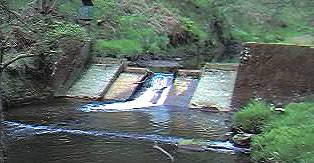
My list is not exhaustive, but I still recorded over 70 plants. Jim Pewtress recorded 35 birds seen and/or heard.
Birds
 Watching the wheatear!
Watching the wheatear!
Red Grouse
Red-legged Partridge
Lapwing
Snipe
Curlew
Black-headed Gull
Common Gull
Herring Gull
Stock Dove
Woodpigeon
Cuckoo
Great Spotted Woodpecker
Skylark
Swallow
Meadow Pipit
Pied Wagtail
Wren
Dunnock
Robin
Redstart
Whinchat
Wheatear
Ring Ouzel
Mistle Thrush
Willow Warbler
Pied Flycatcher
Long-tailed Tit
Marsh Tit
Coal Tit
Blue Tit
Jackdaw
Carrion Crow
Chaffinch
Goldfinch
Linnet
35 Species
| English Name | Latin Name |
|---|---|
| Ash | Fraxinus excelsior |
| Bell heather | Erica cinerea |
| Bilberry | Vaccinium myrtillus |
| Birch, silver | Betula pendula |
| Bird cherry | Prunus padus |
| Bittercress, wavy | Cardamine flexuosa |
| Blackthorn | Prunus spinosa |
| Bluebell | Hyacinthoides non-scripta |
| Bracken | Pteridium aquilinum |
| Bramble | Rubus fruticosus |
| Broom | Cytisus scoparius |
| Bugle | Ajuga reptans |
| Buttercup, creeping | Ranunculus repens |
| Celandine, lesser | Ranunculus ficaria |
| Chickweed wintergreen | Trientalis europaea |
| Common Buckler Fern | Dryopteris dilatata |
| Common Polypody | Polypodium vulgare |
| Corydalis, climbing | Ceratocapnos claviculata |
| Crab apple | Malus sylvestris |
| Cross leaved heath | Erica tetralix |
| Crowberry | Empetrum nigrum |
| Cuckoo flower or Milkmaid | Cardamine pratensis |
| Daisy | Bellis perennis |
| Dandelion | Taraxacum sp. |
| Dogs mercury | Mercurialis perennis |
| Foxglove | Digitalis purpurea |
| Golden saxifrage, opposite leaved | Chrysosplenium oppositifolium |
| Hard Fern | Blechnum spicant |
| Hawthorn | Crataegus monogyna |
| Hazel | Corylus avellana |
| Heather | Calluna vulgaris |
| Herb robert | Geranium robertianum |
| Holly | Ilex aquifolium |
| Honeysuckle | Lonicera periclymenum |
| Ivy | Hedera helix |
| Larch | Larix sp. (L. decidua) |
| Lemon-scented or Mountain Fern | Oreopteris limbosperma |
| Male Fern | Dryopteris filix-mas |
| Maple, field | Acer campestre |
| Marsh marigold | Caltha palustris |
| Mat Grass | Nardus stricta |
| Meadow Grass, Annual | Poa annua |
| Milkwort, heath | Polygala serpyllifolia |
| Mouse ear, common | Cerastium fontanum |
| Nettle, common | Urtica dioica |
| Oak | Quercus sp. |
| Plantain, ribwort | Plantago lanceolata |
| Primrose, common | Primula vulgaris |
| Rowan | Sorbus aucuparia |
| Scots pine | Pinus sylvestris |
| Soft Rush | Juncus effusus |
| Sorrel, sheeps | Rumex acetosella |
| Speedwell, germander | Veronica chamaedrys |
| Speedwell, thyme leaved | Veronica serpyllifolia |
| Stitchwort, greater | Stellaria holostea |
| Strawberry, barren | Potentilla sterilis |
| Strawberry, wild | Fragaria vesca |
| Sweet Vernal Grass | Anthoxanthum odoratum |
| Sycamore | Acer pseudoplatanus |
| Thistle, marsh | Cirsium palustre |
| Thistle, spear | Cirsium vulgare |
| Tormentil | Potentilla erecta |
| Trefoil, lesser | Trifolium dubium |
| Violet, common dog | Viola riviniana |
| Violet, early dog or Wood dog | Viola reichenbachiana |
| Violet, marsh | Viola palustris |
| Wood sage | Teucrium scorodonia |
| Wood sorrel | Oxalis acetosella |
| Woodrush, field | Luzula campestris |
| Woodrush, great | Luzula sylvatica |
| Woodrush, hairy | Luzula pilosa |
| Yarrow | Achillea millefolium |
Number of Species = 72
...plus one that I now think was Blinks (Montia fontana).
© Ryedale Natural History Society 2003; Pictures © Gill Smith 2003
Page last modified 28th May 2003